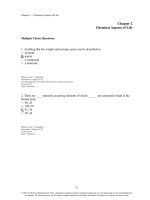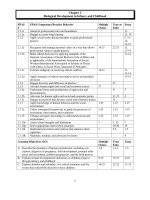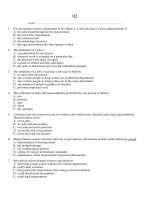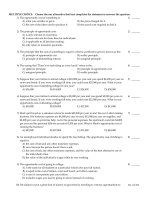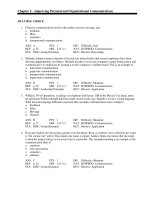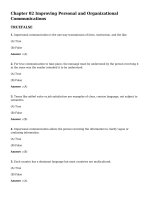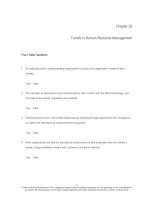Managing hospitality human resources with answer sheet EI 5th edition woods test bank
Bạn đang xem bản rút gọn của tài liệu. Xem và tải ngay bản đầy đủ của tài liệu tại đây (322.18 KB, 8 trang )
Job Analysis and Job Design
Sample Lesson Plan
Competency 1:
Explain the importance of job analysis and how to analyze jobs in the hospitality
industry. (pp. 55–63)
Key Concepts:
Job analysis: process of determining what will be done in a job
Reveals tasks, behaviors, and personal characteristics needed to do a job
Foundation for training programs, job evaluation, compensation planning, and
performance appraisals
Can be used in human resource planning, recruitment, selection, placement,
orientation, training, promotion, career path planning, and safety issues
May reveal bona fide legal reasons for certain types of discrimination in selection
and promotion decisions
Six steps:
Select jobs for analysis
Determine information to collect
Determine how to collect information
Determine who collects information
Process information
Write job description and specifications
Text Exhibits:
Exhibit 1: Job Analysis: The Most Basic Human Resource Management Tool
Exhibit 2: Steps in Job Analysis
Exhibit 3: Methods of Collecting Job Analysis Information
PowerPoints:
PowerPoint slides 1–8
Competency 2:
Describe how the results of job analysis are used in job descriptions and job
specifications. (pp. 63–65)
Key Concepts:
Job description: summary of the duties, responsibilities, working conditions,
activities of a specific job, and qualifications of prospective employee
Job specifications describe qualifications required to perform a job
Although part of the job description, often used as a stand-alone document
Text Exhibit:
Exhibit 4: Sample Job Description: Assistant Director of Human Resources
PowerPoints:
PowerPoint slide 9
Competency 3:
Explain the function of job design, describe how managers apply techniques of
job design, and discuss legal issues related to job analysis and design. (pp. 65–69)
Key Concepts:
Job design: determines how work is done, involves defining the tasks and
responsibilities associated with a job
Techniques:
Job simplification
Job enlargement (horizontal job expansion)
Job enrichment (vertical job expansion)
Job rotation
Team building
2
Job Analysis and Job Design
Human resource laws directly related to job analysis and design include
discrimination, the ADA, the OSHA, and labor laws
PowerPoints:
PowerPoint slides 10–14
Competency 4:
Describe the classifications of employees that make up an organization’s labor
force. (pp. 69–72)
Key Concepts:
What type or classification of employee best fits organization’s needs?
Issues to consider:
Organization’s size
Corporate culture
Image organization wishes to project
What labor market is like
Permanent employees: main staff
Alternative employees: temporary, part-time, outsourced
Text Exhibits:
Exhibit 5: The ADA, Job Analysis, and Design
PowerPoints:
PowerPoint slides 15–17
Competency 5:
Explain the importance of a staffing guide and identify the steps involved in
developing a staffing guide. (pp. 72–76)
Key Concepts:
Staffing guide: scheduling and control tool for establishing labor needs
Five Steps:
Set productivity standards
Determine total anticipated sales and guest volume
Determine number of employees required
Determine total labor hours
Estimate labor expense
Fixed labor expenses: costs associated with the minimum number of employees
required
Variable labor expenses: costs that vary according to the amount of business
Text Exhibits:
Exhibit 6: Productivity Needs Assessment Form
Exhibit 7: Labor Comparison Form
Exhibit 8: Labor Requirements per Hour
Exhibit 9: Sample Schedule Worksheet
PowerPoints:
PowerPoint slides 18–24
Competency 6:
Apply trend line and moving average techniques to forecast business volume and
labor needs. (pp. 76–79)
Key Concepts:
Trend line forecasting
Graphing the sales from similar periods and fitting a line to the average sales
projected for past periods to estimate future sales
Does not account for irregularities
Moving average forecasting
Expressed as the activity in previous n periods divided by n, where n is the
number of periods in the moving average
Job Analysis and Job Design
3
Involves continually adding new results and dropping the oldest week off the
model
Accounts for irregularities by “smoothing” out data collected from a specific
time period to project anticipated sales
Seasonality is part of forecasting and must be taken into account
Other popular methods in Exhibit 12
Text Exhibits:
Exhibit 10: Sample Ten-Day Volume Forecast—Food
Exhibit 11: Sample Three-Day Revised Forecast—Food and Beverage
Exhibit 12: Summary of Lodging Industry Short-Term Sales Forecasting Methods
PowerPoints:
PowerPoint slides 25–29
Class Activities
Optional Test
A ready-to-use test containing questions related to the competencies covered by this chapter is included
in this session. These questions are similar in format and content to the questions on the Final Exam that
the Educational Institute provides and grades for students who are enrolled in this course with the
Institute. (If your students are not enrolled in the Institute's course, they will not receive this Final Exam.)
The answers to this session's optional test are:
1-d-C1, 2-b-C1, 3-a-C1, 4-c-C2, 5-b-C3, 6-c-C3, 7-b-C3, 8-c-C4, 9-a-C4, 10-d-C5
Each question is linked to a competency. Competencies are listed on the first page of the chapter and in
the Sample Lesson Plan. An answer reading 3-b-C4 translates to:
3: the question number
b: the correct answer
C4: the competency number
The pages in the text that are associated with this chapter's competencies are as follows:
C1: 55-63
C2: 63-65
C3: 65-69
C4: 69-72
C5: 72-76
C6: 76-79
Note that the answers to test questions may not appear verbatim on the referenced pages. Test questions
may assess the examinees' ability to apply a concept, not just their knowledge of the concept.
These questions can also be found on the test disk in Rich Text Format (.rtf) files. You can use these
questions as a starter to create your own tests.
Individual/Group Activities
Activity 1: Mini-Case Study
Refer to the mini-case study in the textbook and use the accompanying discussion questions to stimulate
class and/or small group discussions.
Activity 2: The "Quick Brown Fox" as a Job Analysis and Design Exercise
One way to help students understand why it is important to conduct a thorough job analysis is to assign
each student the responsibility of writing a single letter of a message passed around the room.
Cut strips of white paper about one-and-one-half inches wide.
Give each student twelve to fifteen strips.
4
Job Analysis and Job Design
Assign each student the responsibility of writing a single letter in the sentence "The quick brown fox
jumps over the lazy dog" (any sentence would work).
Explain that writing a single letter in this sentence as it goes around the room simulates a
manufacturing organization.
After completing several sentences, stop and ask students what they have learned about their jobs.
Conduct a job analysis using techniques described earlier.
By now, of course, the students are “experts” at their jobs. Further discussion typically leads to student
suggestions to make their work more interesting and expanding production. This provides an
opportunity to discuss job rotation (allowing students to write different letters—in effect, cross-training
them), job enlargement (asking students to each write two letters), and job enrichment (allowing each
student to write the entire sentence).
Activity 3: “Analyze Your Own Job”
This activity helps students understand the specific requisites and outcomes of a job. It shows how job
analysis can be used as a human resources management tool.
After the class discussion of job design, hand out the job analysis worksheet (Handout 1) and ask each
student to fill it out and bring it to the next class. For the job analysis, students may use a job they have
performed, a job they are familiar with (such as a job performed by a relative or friend), or a job they
hope to perform in the future.
At the next class meeting, divide students into small discussion groups of four to five each to discuss
their job analyses. Each student should spend a couple of minutes presenting his or her findings to the
small group. Ask each group to compare the information collected by its members and draw conclusions.
Each group should decide on one job analysis as the best example of the common principles discussed. At
this point, reconvene the class. Review the main concepts from the transparency of the flow chart of
Exhibit 1, Job Analysis: The Most Basic Human Resource Management Tool. Ask one group to briefly
present a job analysis for class discussion. Ask the group to show the other students how the factors in
the flow chart affect the job analysis they have presented. Ask students to offer examples of ways in
which the job analyses presented in the small groups fit into the Exhibit 1 flow chart. If time permits,
invite other small groups to present their job analyses.
Job Analysis and Job Design
5
Job Analysis and Job Design
NAME: __________________________________________
DATE: _____________________
1.
Analyzing the difficulty, frequency, and importance of work activities associated with a particular
job is a fundamental aspect of:
a. job simplification.
b. job specification.
c. job design.
d. job analysis.
2.
Which of the following statements about job analysis is false?
a.
b.
c.
d.
The degree of change associated with a position determines how often a job is analyzed.
The frequency of job analysis depends primarily on the skill levels associated with the position.
Observation is the simplest and least expensive method of collecting job analysis information.
Adding new items to a menu may prompt a job analysis of cooking jobs in a restaurant.
3.
Which of the following methods of collecting job analysis information is most likely to be influenced
by the Heisenberg Effect?
a. interviews
b. observation
c. critical incidents
d. daily logs
4.
Which of the following managerial tools summarizes the duties, responsibilities, working conditions,
and activities of a specific job?
a. job specifications
b. job analyses
c. job descriptions
d. job designs
5.
Broadening a job to include additional tasks requiring similar skills and abilities is referred to as:
a. job simplification.
b. job enlargement.
c. job rotation.
d. job enrichment.
6.
Which of the following job design techniques requires cross-training employees?
a.
b.
c.
d.
7.
job simplification
job enlargement
job rotation
job enrichment
The food and beverage director at a downtown hotel cross-trained buspersons to deliver room
service orders. This is an example of:
a. job simplification.
b. job rotation.
c. job analysis.
d. horizontal job expansion.
6
Job Analysis and Job Design
8.
Which of the following tools do managers use when budgeting labor expenses for their
departments?
a. performance standards
b. productivity standards
c. staffing guides
d. job specifications
9.
Which of the following statements about fixed and variable labor expenses is false?
a.
b.
c.
d.
An unexpected increase in business volume will increase fixed labor expenses.
Managers have more control over variable labor expenses than they do over fixed labor
expenses.
Staffing guides are useful tools for controlling variable labor expenses.
Fixed labor expenses are costs associated with the minimum number of employees needed to
operate a business.
10. Given the data below, use a five-week moving average to forecast lunch covers for Week 9 at The
Fork and Spoon Restaurant.
Week 1–425 covers
Week 2–500 covers
Week 3–475 covers
Week 4–525 covers
Week 5–500 covers
Week 6–530 covers
Week 7–520 covers
Week 8–500 covers
a. 485 covers
b. 506 covers
c. 510 covers
d. 515 covers
Job Analysis and Job Design
7
Handout 1
Analyze Your Own Job
Complete the job analysis and bring it to the next class. For the job analysis, you may use a
job you have performed, a job you are familiar with (such as a job performed by a relative or
friend), or a job you hope to perform in the future.
Job analysis is a listing of duties and requirements and their importance to a given job. Job
analysis data always describes the job, not the person doing the job.
What is the job title? Does the title explain what the job is? If not, what title would offer a better
explanation?
How does the job fit in with the rest of the company? What jobs are comparable? Is the
wage/salary comparable to other jobs within the company? Within the industry? Use reference
materials (library, Internet) to justify your answer.
What is the chain of command? To whom does the person with this job report? Is this person
responsible for monitoring the work of others? Describe the internal and external contacts of the
person holding this position.
8
Job Analysis and Job Design
Handout 1 (continued)
What duties and tasks does the person holding this job perform? What are the physical
requirements of the job?
What tools and equipment are required for this job? Include any computer equipment.
Describe the baseline knowledge, skills, and abilities necessary to perform this job.

